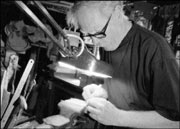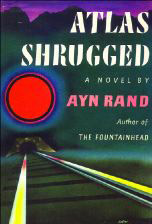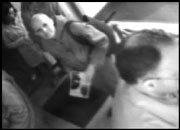WOOD WORKS SHOWCASE
Starbucks Literary Stage 1-2 p.m. Mon., Sept. 2
MERE BLOCKS from the Buckaroo Tavern, Paul Hunter works 10- to 12-hour days in the basement of his house on Greenwood Avenue North. The retired Overlake High School teacher (English, American history, creative writing, golf) now spends most of his time as the sole owner and operator of Wood Works Press, the local poetry press that has published 15 books in the last seven years—most of them chapbooks. For 13 of those books Hunter served as the publisher, the editor, the illustrator, the binder, the typesetter, and the promoter. He wrote the other two books himself.
Wood Works’ latest releases are John W. Marshall’s hospital chronicle Blue Mouth and Amy Bonomi’s environmentally charged Coming of the World; Tom Parson’s To Be Self-Evident, the result of years of conversation with Hunter, is forthcoming. All three will be showcased—and read from by their authors—this weekend.
Wood Works’ output isn’t spectacular—unless you consider Hunter’s resources—but Hunter provides for his writers the kind of devotion they wouldn’t get anywhere else. “At this point, I get a lot of submissions,” he says, estimating the number to be just under a dozen per month, “most of which I have to say no to. If there’s something interesting in the writing, I will open a conversation with a writer and see where it leads.”
The books themselves are works of art. “The words are all handset with lead type, and all the illustrations are hardwood blocks—they’re mostly maple or cherry blocks—that I carve with little chisels and knives. Slab cutting is the way that it was done at the very dawn of printing. The most beautiful books ever printed were done in the first 50 years after the invention of moveable type because printers had few types to choose from, and all their types were simple and strong. The graphics, too, were medieval-style woodcuts. Now we’re used to graphic designers constantly changing the size of things, but when you look at one of my woodcuts you’re seeing it in exactly the same scale that I drew it and carved it. So there’s a kind of honesty and a directness that you can’t get any other way.”
A single-edition run of chapbooks takes Hunter about seven weeks—working seven days per week—to complete. They are each numbered and, often, autographed. “I’m really interested in getting the works in the hands of people—enlarging the audience of these writers—and part of my commitment in that is to price them cheap enough so anyone can buy them.” (They sell for a mere $9 each.)
“Also, all my books have visual continuity. They are very spare and they’re small. I’m serious about the size of the book as an important thing. You know the name of Dylan Thomas’ first book? 18 Poems. His second book was called 25 Poems. They were little, tiny books. I think of books that could have been freestanding: Howl itself without all those other poems, or The Wasteland. Those would have looked good as one of these little chapbooks.”
After Ginsberg and Eliot, our conversation stumbled onto the subject of magnetic poetry. “You mean the stuff all over my refrigerator? I haven’t actually done anything with those magnets, but . . . what do we have here, let’s see . . . .” He reads off his refrigerator door: “No green glass piece / steel smile / smoke and embrace / perhaps melt young / soon to haunt those / we bleed salt / red ocean.”
He laughs.
“Do you think it’s publishable?” I ask.
“Well, I don’t know,” Hunter says. “It’s a little jumpy.”







